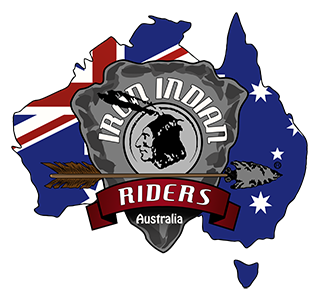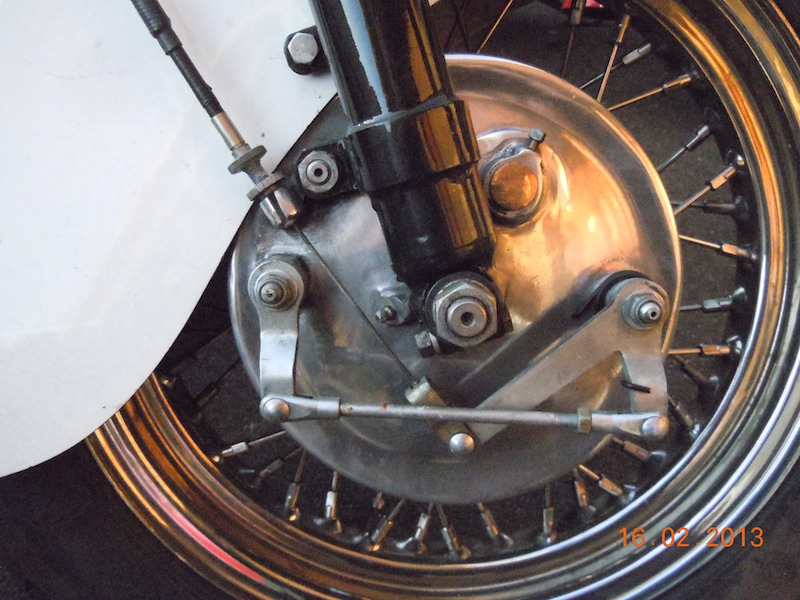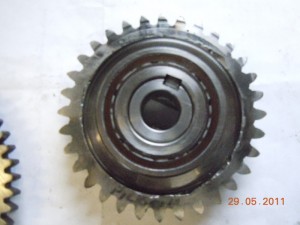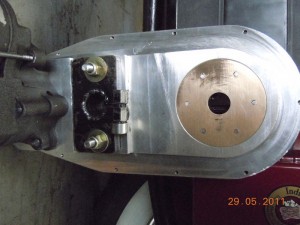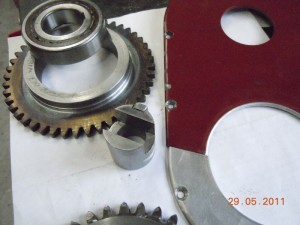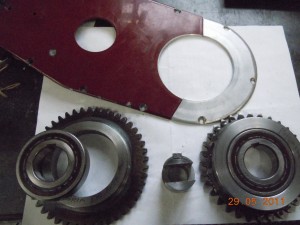Tech Articles
Produced by AllMoto ABN: 61 400 694 722
Privacy: we do not collect cookies or any other data.
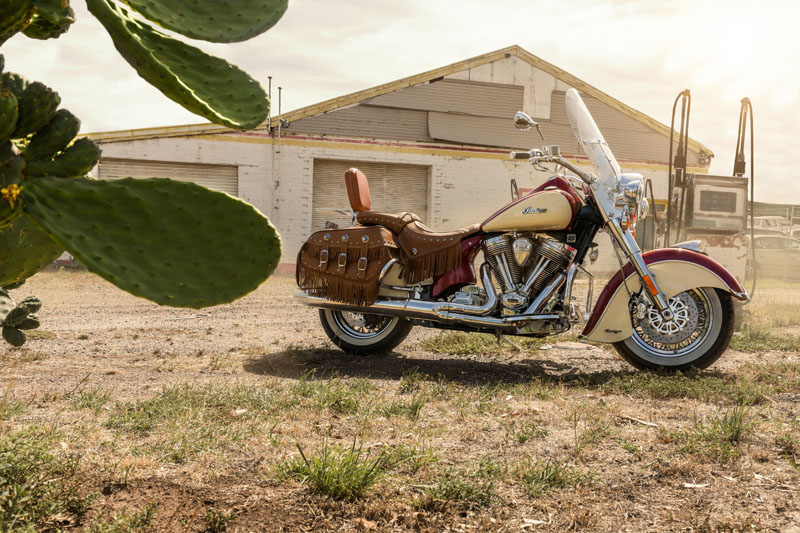
Our Bikes – Indian Chief Vintage 2009
(MT #304, Jan 2016, updated June 2020)
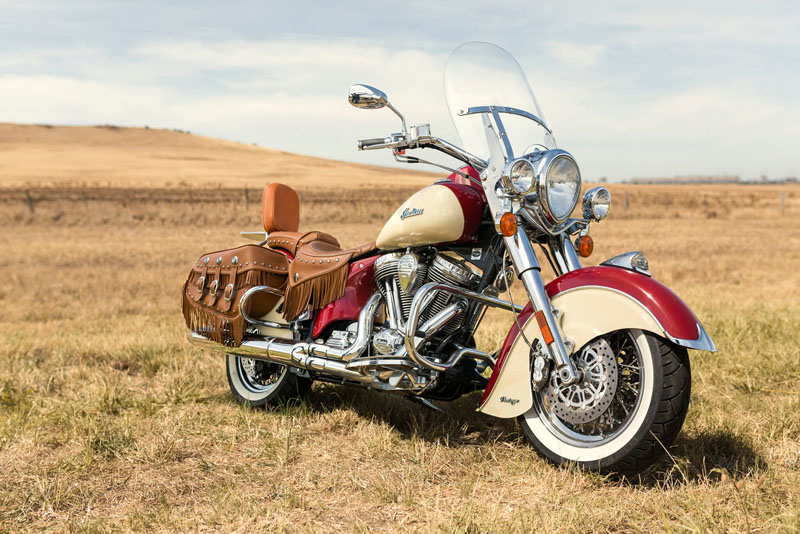
King Vintage
by Guy ‘Guido’ Allen; pics by Ben Galli Photography
Adding a Kings Mountain Indian Chief Vintage to the shed – and a little drama along the way…
Every now and then someone will come to me looking for advice on buying their next motorcycle. I suspect this is a little like asking Dracula for a few tips on setting up a blood bank, but it happens.
If what they have in mind is a little obscure or specialist, I’ll usually advise they join a marque club to get an insight into what to look for and, more importantly, get a heads-up on the bikes that often never hit the open market, as they’re sold by word of mouth.
However there are dangers. I joined a local Indian club (ironindian.com.au) some years before Polaris revived the marque. That resulted in the acquisition of one Indian – which is enough for most people. Then there were three in the shed. I may have to leave the club before it causes bankruptcy. Our latest addition is a 2009 Chief Vintage, bought and sold by word of mouth.
The new transport of delight was built at Kings Mountain – the factory bought out by Polaris. Indian at Kings Mountain was actually trading pretty well at the time (2011), building low volume to a high standard – some 1134 bikes in all. In a contemporary interview, we asked former company President Stephen Heese how the firm had been travelling just prior to the sale.
“Brilliantly,” he said. “We were blessed to have recruited a terrific group of people – passionate motorcycle enthusiasts with real experience in the industry. In two-and-a-half years we had a bike on the road. In a year-and-a-half we had a bike in testing, and started producing a year after that.
“We created a lot of happy customers, didn’t have a lot of warranty claims. We attracted a lot of attention. The company wasn’t for sale, and Polaris made us an offer we couldn’t refuse.”
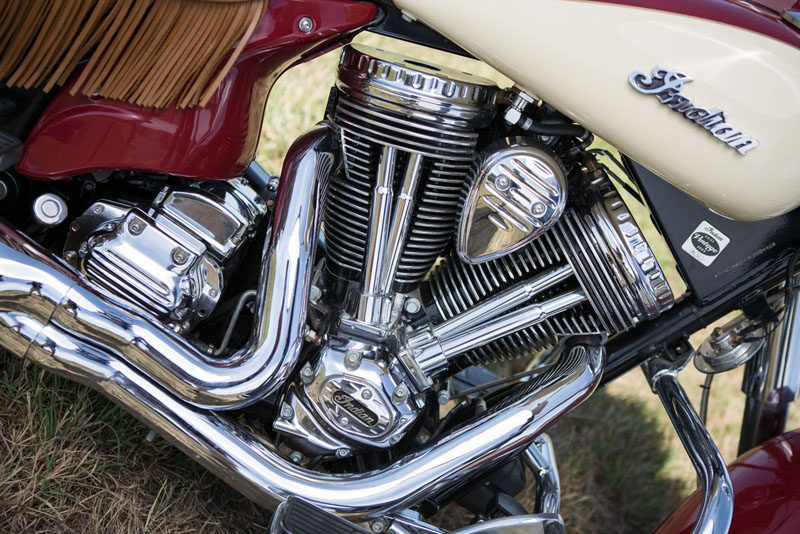
SAME BUT DIFFERENT
So what’s a Kings Mountain? Essentially it’s a Gilroy – which itself was a clean sheet design circa 1999-2003 – with a lot more development put into it. The bikes were hand-built, with total production volume said to be around the 1100 mark (see list below). Of those, 500 were Chief Vintage, individually numbered with a plaque riveted to the steering head. (Gilroy did the same with its Chief Vintage.)
Like the Gilroy, this toy has an incredibly long wheelbase at 1737mm, compared to 1625 for the equivalent Harley-Davidson Road King. The steel frame is pretty solid, running Paoli front suspension (41mm shrouded conventional forks) and Fox rear shock – Gilroys ran a KW rear.
Tyre width at the back was bumped up from 130 to 150 to give it a more current look.
However the big change for the chassis was a much-needed upgrade from a single to twin floating brake discs up front, running four-spot Brembo calipers. This was a welcome improvement on a machine weighing 356kg with a load of fuel on board.
Its heart is a Powerplus 45-degree air-cooled V-twin with two pushrod-actuated valves per cylinder, and self-adjusting hydraulic tappets. Capacity is 1720cc (105 cubic inches), up from 1638cc (100 cubic inches) on the original. Both the ‘bottlecap’ motors are dry sump.
Where Gilroy went wrong on the original Powerplus was with the supplier of its crankshafts. I’m told they went for the cheapest quote, but can’t confirm that. In any case they started failing, breaking crank pins by 5000km at the very latest. This was one problem too many for what was then probably a cash-strapped company and it closed down.
Fixes quickly became available and you can still buy replacement cranks and even entire engines for a project bike. Properly built, they have proven to be capable of decent miles. But the damage to their reputation was too much.
The approach of the Kings Mountain factory was to take the bike and move it up a level. Externally, lots of details were fixed such as some simplistic design of engine cases, particularly for the timing side of the crankshaft. Everything was smoothed and lots of chrome added. Internally, the quality control was lifted.
In addition to the capacity jump (I suspect for bragging rights and branding rather than necessity), the engine gained fuel injection. That replaced the simple and effective Mikuni HSR42 carburettor, a common fitment to Harleys over the years.
Last, and far from least, was the upgrade from a five to six-speed transmission by Baker. It’s debatable whether the extra cog was necessary.
Put the two bikes together – I’m one of the few people who could at the time – and you quickly understand how much Kings Mountain invested in its upgrade. Changes such as paint, instruments, general finish, motor, transmission, brakes, acres of additional chrome, seat, luggage, screen and even little ‘easter eggs’ like branded handlebar end covers abound. They went to a hell of a lot of trouble to make the owner feel good about the purchase.
As a quick example, the perfectly functional if basic leather saddelbags on the Gilroy bike were replaced with a set that has bigger capacity, pockets for incidentals, quilted linings and the whole lot is held on by one of the best quick detach/remount systems I’ve come across.
The investment in build quality and exclusivity was reflected in the price, which was around US$35,500. Despite that, the reviews of the day were positive – more so than for the Gilroy.
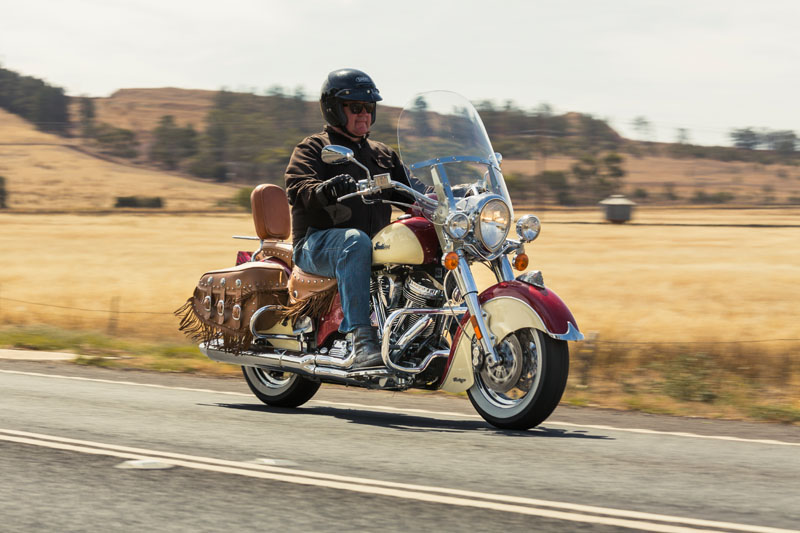
BETTER WOMBAT TRAP
With under 300km on the odo when I collected it, the new gizmo qualified as NOS – new old stock. I’ve yet to crack the 3000 mark (hey, there are other toys that need attention too!) but at least have some sort of handle on the plot.
It’s smoother than the Gilroy, though the solid-mounted engine still vibrates. Starting is a little simpler (though has never been an issue on the Gilroy) and the general fuelling is smoother and more tolerant of any clumsiness from the right wrist.
Ride and handling is good, for what it is. We’re talking land-yacht when it comes to steering (look for wide lines in corners), but the suspension rates are well chosen and tend to be firm rather than the floaty experience you get on a lot of equivalent cruisers.
Braking is very good for this class – plenty in reserve with decent feel. The extra rubber on the rear is a bonus in this department, given the typical rear-heavy weight distribution on a bike like this.
There’s a multi-function display built into the speedo dial, with battery charging, trip meters and tacho included, all of which are accessible from a button on the left switchblock.
Performance is decent for the class but hardly head-spinning – we’re talking about 72 horses in a heavy stock package. In reality, what you have is a heavyweight touring cruiser that has some urge, proper brakes, predictable handling and a very nice level of finish.
On the highway it’s bumbling along at about 2000rpm for legal speeds, well below its peak torque and power numbers. So you can drop it down a couple of gears and get something happening when you need to. The trick is to ride the midrange, rather than looking for peak revs.
While the ultra-long chassis makes it a yacht in corners, it allows a huge amount of room for the rider. It fits tall people – yay! Given my usual grumble about how the world is designed for midgets, this is a refreshing change. Oh, and its sheer size gives it enormous presence.
So, good decision? Yep. I really like riding the Gilroy and have done a lot of miles on it. This, the Kings Mountain is another level again. It is a better mousetrap. Given its size, maybe that should be a better wombat trap…
***
JUNE 2020 UPDATE – BCM DRAMAS
The day it went to lunch
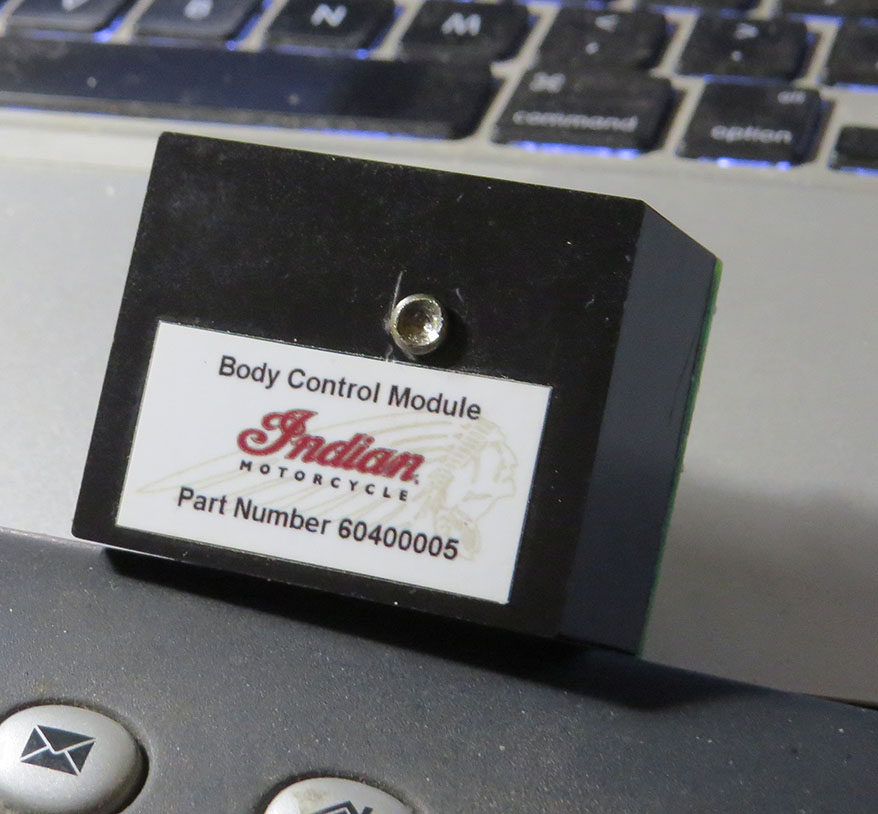
One of the dubious joys of owning a limited production bike is there will inevitably be issues and not many people know how to fix them.
For me, it was the day the bike stopped running. We had some, but not all, lights and no starter or ignition. Back home in the shed, it was simple enough to check the starter itself hadn’t failed, by removing the right-side electric motor cover (three bolts) and pushing in the mechanical contact switch with a screwdriver to engage it. This bypassed the starter relay. It turned, but no ignition.
A lot of digging for info revealed there was a recall many years ago on body control modules (essentially an electonic control unit, separate to the one for the engine/injection) and the design had been updated.
You can still buy them as a Polaris part, from America, and the cost is significant at around US$500. While there are local people who will repair body control modules for cars, they run away the minute you say “motorcycle”. Oh well…the new unit did the job and I just ordered a spare. (Call me a cynic…)
The updated part number is, by the way, Polaris 2411878. I got mine through Megazip.net. That’s a parts consolidation company and is worth trying if the normal channels aren’t working for you.
In the meantime – are there any budding BCM geniuses out there? Drop me a line at allmoto@optusnet.com.au, as I’ve kept the old unit (pictured) and will be curious to see if it can be repaired.
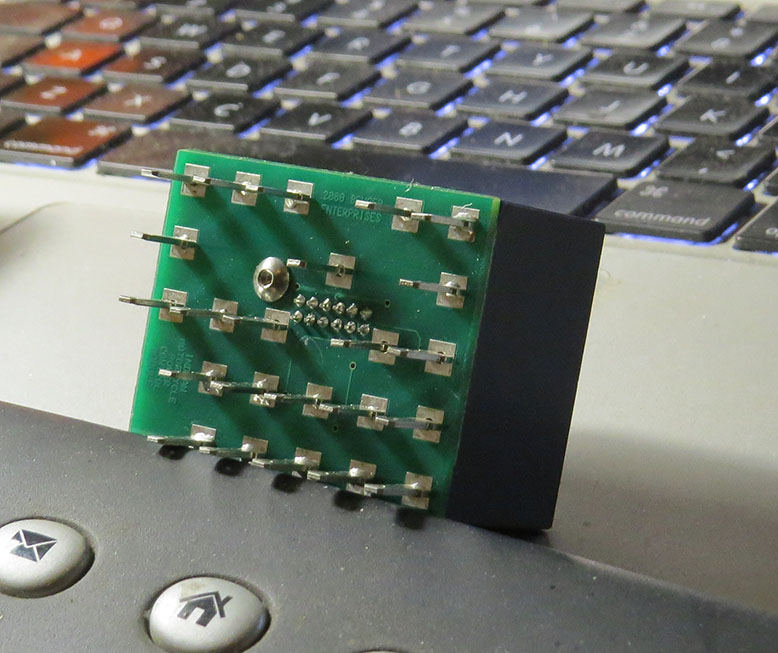
THREE FACTORIES
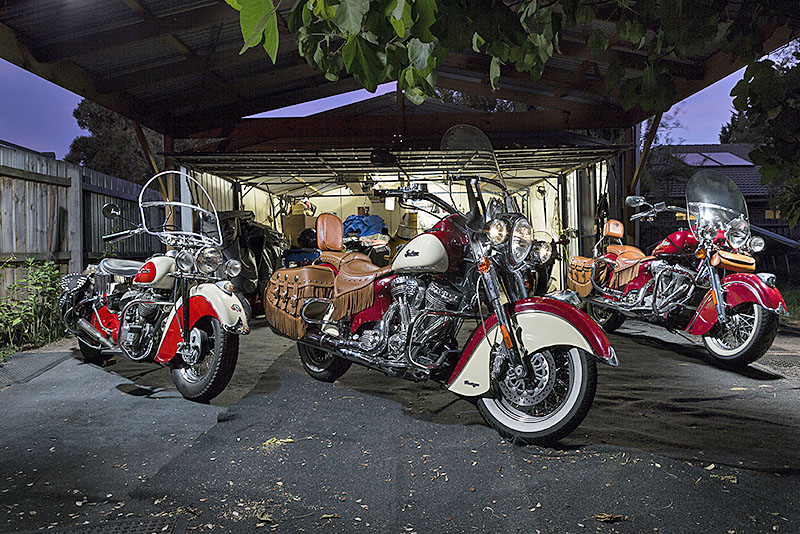
The three bikes you see here represent the three major factories before Polaris took over and started building them at Spirit Lake in 2014.
Indians are often described by their place of manufacture, for example Springfield or Gilroy, as a shorthand for saying which generation and factory they belong to. The lineage is this:
Springfield 1901-1953
Gilroy 1999-2003
Kings Mountain 2006-2011
Spirit Lake 2013 (for the 2014 model year) to present.
There were other bikes carrying the Indian name sporadically produced between 1953 and 1999, and they were generally rebadged British machines from the likes of Royal Enfield and even Velocette, or the odd minibike producer.
Flying the flag for Springfield in the pic is a 1947 Chief (left).
The all-red machine (right) is a Gilroy Chief Vintage, running the first-generation modern Powerplus motor. Powerplus is an old Springfeld name, revived for this and the next generation bike.
Third (centre) is the Kings Mountain machine from the main feature.
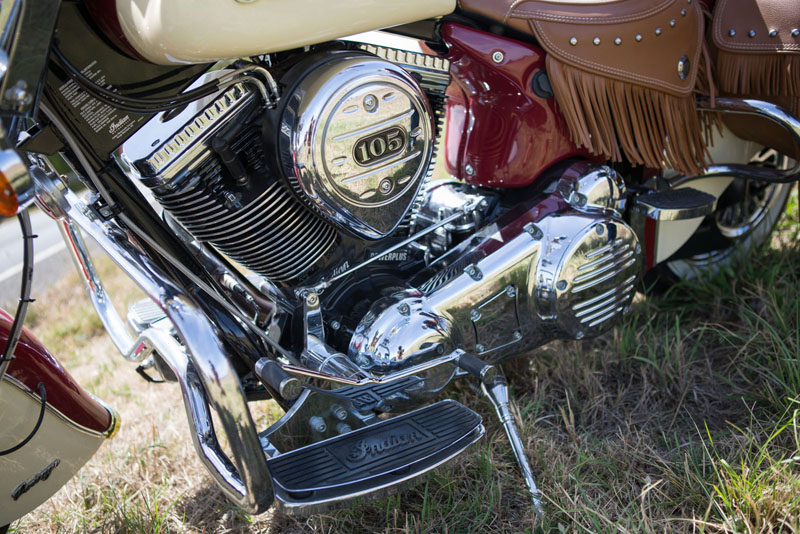
INDIAN DATES
1901 – Indian Motorcycle Company, founded by George Hendee and Carl Hedstrom, produces its first prototype. It was a 1.75hp single, produced in Hendee¹s home town of Springfield, Massachusetts.
1930 – Merges with duPont Motors.
1945 – Sold to Ralph Rogers and the Atlas Corporation. The company swings its attention to lighter motorcycles.
1953 – Indian ceases production. The rights to the name are bought by Brockhouse Engineering, which sells re-badged Royal Enfields.
1963-1970 – Floyd Clymer produces a wild variety of machines under the Indian name, though it¹s doubtful he held the rights to it.
1999 – After much bitter court wrangling, an amalgam of nine companies becomes the Indian Motorcycle Company of America, producing out of Gilroy, California.
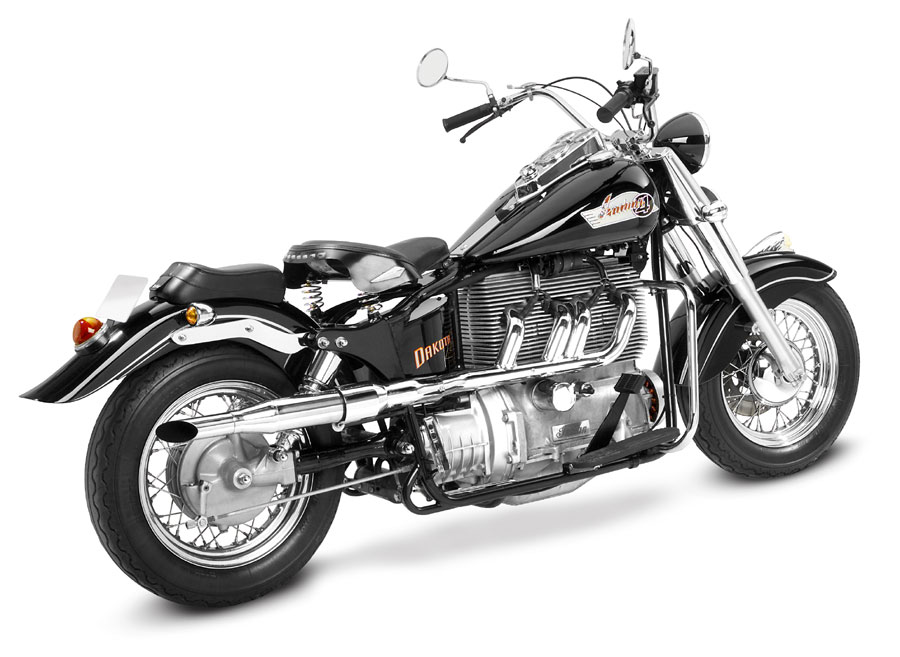
2000 – The rights to the Swedish-designed four-cylinder Viking cruiser are bought by English musician Alan Forbes, who then owned the British rights to the Indian name. Hand-built production of the design (which replicates an historic inline Indian 4) begins, badged as an Indian Dakota (above).
2003 – Gilroy shuts down, in September.
2008 – A new Indian Motorcycle Company, backed by British finance group Stellican (which also revived historic boat brand Chris-Craft), buys the Gilroy design and starts production of an updated version at Kings Mountain, North Carolina.
2011 – Polaris, maker of Victory brand cruisers, buys Indian in America.
2013 – Production of the Polaris machines begins, for the 2014 model year, at Spirit Lake, Iowa.
KINGS MOUNTAIN PRODUCTION
2009 460
2010 340
2011 109
2012 140 Polaris Built
2013 85
LE Models 35
FE Models 25
Other 25
Total KM Design bike production 1134
(Figures from Mark Moses)
SPECS
Indian Chief Vintage 2009
ENGINE:
TYPE: air-cooled, two-valves-per-cylinder, 45-degree V-twin
CAPACITY: 1732cc
BORE & STROKE: 101 x 108mm
COMPRESSION RATIO: 9:1
FUEL SYSTEM: sequential fuel injection
TRANSMISSION:
TYPE: Six-speed, constant-mesh, ?by Baker
FINAL DRIVE: Toothed belt
CHASSIS & RUNNING GEAR:
FRAME TYPE: Steel cradle
FRONT SUSPENSION: 41mm conventional telescopic fork by Paoli
REAR SUSPENSION: single prelo-adjustable shock by Fox
FRONT BRAKE: twin floating discs with 4-piston Brembo calipers
REAR BRAKE: single floating disc with 2-piston Brembo caliper
DIMENSIONS & CAPACITIES:
WET WEIGHT: 356kg
SEAT HEIGHT: 708mm
WHEELBASE: 1737mm
FUEL CAPACITY: 21.2lt
WHEELS & TYRES:
FRONT: 130-90-16
REAR: 150/80-16
PERFORMANCE:
POWER: 54kW (72hp) @ 5000rpm
TORQUE: 136Nm (100lb-ft) at 3000rpm
OTHER STUFF:
PRICE WHEN NEW: US$35,500
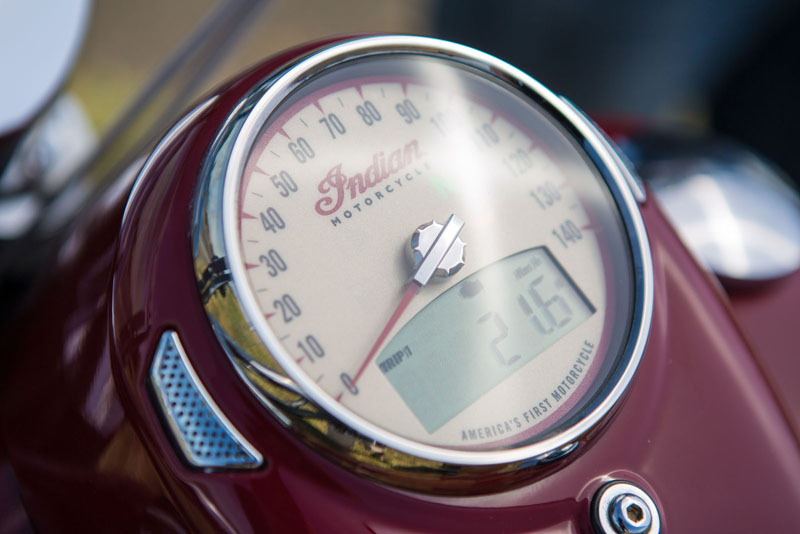
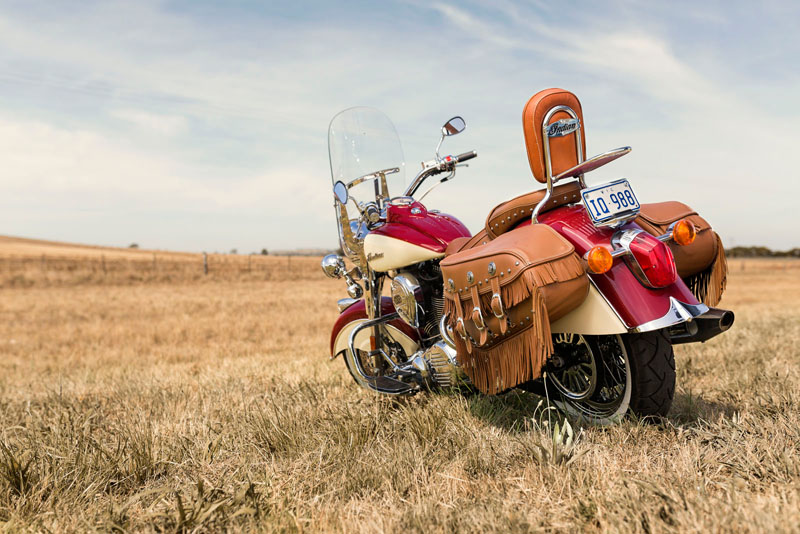
AOMC Motorcycle Club forum 2019
Chair: Keith Mortimer AOMC President.
Guests: John Lewis (CPS Policy, VicRoads), Shane Ellis, Lee Johnstone (Safety & Compliance VicRoads).
John Lewis (VicRoads) gave an introduction to the forum. 2009 CPS changes accelerated vehicles on CPS from 8500 to 30,000 by 2014. At the time there was concern from car clubs about the modifications being made to vehicles and the lack of oversight and clear standards. VicRoads introduced the M plate scheme for modified CPS vehicles. At the time there was discussion but no consideration over the issue with motorcycles. Happy to start talking about motorcycle modifications.
Questions from the floor:
Is there an M Plate for motorbikes? A: No. Have to meet RW requirements and VSI – 4 requirements. In theory, motorbike cannot be modified beyond VSI-4.
Self assessment can be done on motorbikes up to 1949. In our club (Vincent) the bikes went out of production in 1956 but are still basically the same bike that was produced in the 1940s. Seems unfair that the same bike has different treatment depending on date of production. A: Had to be some cut off date. 1949 was considered the start of most modern vehicle systems and hence the date that ws introduced. No matter what year was picked, same issue would have arisen. Has to be clearly defined points to classify. As soon as one exception is made, it opens flood gates for other vehicles. Have to maintain consistency.
If a car is put on H plates and is then modified, does it keep the H plate or does it have to have an M plate? A: When a VASS report is done an M plate is issued. Have no information on database of what modifications have been done. Rely on clubs and public to report vehicles that should be classified differently. Follow up these reports with a letter to the club and owner to prove the car is not modified beyond specifications or provide engineers certificate. Have even been sent You Tube clips of H plate vehicles in drag races. VicRoads have a dedicated email address for these reports.
BSA Owners Club has over 600 bikes on CPS. Keeping of records by clubs seems to be double handling and time consuming as clubs, RW testers and VicRoads all keep and administer these records. A: VicRoads are keen for clubs to keep records because at times they need to go back to the club to prove vehicles have been inspected properly. Makes clubs responsible for the condition of the vehicles. It is also a protection for the club.
VicRoads do a great job but have limited resources. Shouldn’t clubs be more responsible and demerit point system introduced, as if there are no penalties no one cares. A: Police are issuing fines for unroadworthy and over modified vehicles without proper certification. When vehicles are reported to VicRoads and a letter is written to the club, usually the clubs take the matter very seriously. Many illegal modifications are done after the club and VicRoads have issued permits for the vehicle, which was acceptable at that time. Similar things are happening with late production vehicles and VicRoads are cracking down on certifiers who pass these vehicles as fit for road use.
Monarchs Motorcycle Club require members to sign a form each year stating their bike has not been modified, and also have an attendance requirement so vehicles can be sighted. Other clubs do annual checks on vehicles, but not all can be seen. There are some clubs that offer CPS membership for $100 and never see the vehicles. A. VicRoads do audit clubs that have been reported as being ‘Dodgy’.
What is an e roadworthy? VicRoads are in process of transferring roadworthy testing to an online system rather than a paper based system. This means all records and photographs can be stored on a database. These records will be kept in a cloud
Do VicRoads keep stats on convictions of people doing the wrong thing, such as false plates and shared plates? No, VicRoads do not have that information, perhaps the police do. Not aware of any stats they might have. VicRoads looking at technology to link plates to the car to identify theft and cloning, which may eventually be linked to the CPS.
What is VicRoads view on replica vehicles on CPS? At present, VicRoads recognises bikes as what they claim to be, so a 2015 replica of a historic model is eligible. If a bike is identified by a compliance plate, that is its identity forever. There are a number of bikes on the system they believe are not in the spirit of the system, John Lewis will be sending out information to clubs on what the rules regarding replica motorbikes are.
When log book scheme first came in there were only 300 clubs in Victoria. Now there are more than 1300 clubs. Could VicRoads look at the situation where people go out and form clubs with only 6 or 7 people. A consultant was engaged to go out and talk to clubs, and will come up with a set of criteria that can be used to determine if a club is legitimate.
Have VicRoads ever taken a clubs permit facility off them? Yes, over time some clubs have been closed from the CPS.
How do clubs accommodate things like the cafe racers and Japanese bikes that were built without an ID plate without the facility of an M plate? If the bike has been modified away from its original configuration and beyond VSI-4 guidelines, the owner and club would be encouraged to engage with a VASS signatory to look at the vehicle and check it for fit for purpose. The clubs could use this as an assurance that the bike is within the rules. VicRoads acknowledge that the same consideration to modifications in cars has not been given to motorbikes and needs to be addressed. VicRoads need to ensure that any modifications have been done safely. Part of consideration from this meeting is to get feedback and support from clubs as to how modifications on bike could be self certifying or an independent signatory could be bought in to certify.
Rorting of log books has been occurring. Is there any thought of introducing a phone app log book? VicRoads have had some thoughts of looking at apps or electronic log books similar to the learner log book. Have not progressed very far. Have tried to alter logbooks to make it harder to tamper with entries. A lot of club members are against the idea of e-log books, but it may come to being if rorting continues.
After market frames made by Rickman for bikes like Kawasaki ZA that are pre engineered are bought out as an extra component that is street legal. Do you still need a VASS engineers report if using one of these. If it is not a Kawasaki frame from the original manufacturer, it comes under the category of an individually constructed vehicle (ICV). Would need to speak to a VASS engineer.
Rickman bikes were sold in the 70s and there are plenty around. They have been road registered with VicRoads all this time. Legacy challenge if a ICV was built in the 70s. Records would reflect that and would be treated accordingly. If it has never been registered it would have to be treated as if built yesterday.
When out with club on a multi day rally, the rules are that you cannot fill your log book out in advance, but have to record each day on the day. Can you explain why? Do not want books pre filled in so that people do not fill out book entry quickly as policeman is approaching vehicle.
One attendee recounted how he was on a 3 day club run and he always prefills his log book for each day with dates and where he is going. Was pulled over by police who knew CPS inside out and said it was all good to fill in that way, but said that you might be wasting a day or two of your allocation if you pull out of the run or have a mechanical. Not the reason for no pre filling, always merely over being able to quickly fill in when stopped.
Could you clarify commercial use in terms of advertising displayed on vehicles? CPS set up for private use, but some have heritage advertising. There are some vehicles that advertise current businesses. Only used for display, and not used for carrying goods so is a grey area.
Car is taking part in a charity rally with logos on it and is on CPS. How is this viewed? Is still being used for private use rather than commercial use.
Recently have had bikes knocked back in regional Victoria when applying for CPS after being passed by scrutineer. Reason was scrutineer signed off that member was financial, and VicRoads officer said this had to be signed by appropriate club official, not the scrutineer. The form that is submitted with signatories are in 2 parts. Top part is the club officials who can sign applications & renewals to verify membership. Second part is the scrutineer part where the scrutineer signs. Can only sign the renewal if name is on the top part.
Recently had to get a RW on a 2 year old vehicle and was told that he had to have a noise test which entailed the bike going off to another business for several days. Another tester approached said it did not need a noise test. Which one is correct? If there are requirements for a roadworthy to have a noise test, then tester would have to demonstrate that he has taken that step. Roadworthy tester in the audience reported that noise testing only needed if muffler does not meet specifications.
Any conversation/instruction with VicPolice re what to look for in regards to M Plates? Are undertaking a project of informing VicPolice on defects and modifications. Should be rolled out within the year. VicPolice approached VicRoads on this matter, and technicians have met with instructors at the police academy.
The CSTeam section of VicRoads have a very difficult and lengthy process. No telephone contact available so cannot talk to anyone. How can communication be improved? Like contact to be via email so as to keep track of enquiries and send out to appropriate area. There is a customer resolution team that can be contacted.
Frame straightening, what is VicRoads view on this? Like engine or fork replacement, when bike moves further away from original manufactured vehicle. There is a section of VSI-4 that permits repair or modification. Anything deemed beyond that level of repair would need a VASS certification.
Pre 1960 bikes do not have indicators. Can VicRoads include in motorcycle awareness information for car drivers to recognise motorcyclists using hand signals. Is certainly in the regulations that if turning signals not present, then hand signals are allowed.
Member of club is building a bike with a Rickman frame at present. What should I do when he presents it for scrutineering? Will need to get a VASS certificate if it has never had an identity.
Chairman Keith Mortimer suggested that as the Rickman issue is quite complex, the clubs and VicRoads need to get together on this issue to discuss. VicRoads attendees are happy to do.
CPS is eligible when 25 years old to the day. A member started process on date of 25 year anniversary and VicRoads officer knocked him back and told him he had to wait another month to apply. If compliance date only gives month of build and not exact day, then it is considered to be at the end of that month for CPS eligibility purposes. A manufacturers or dealers letter would be sufficient to verify exact date.
Problem is that John Lewis knows the rules when you speak to him on phone, but not all front desk officers are as aware. Front desk officers need to cover a huge area of rules and regulations and in the main they are right, but mistakes can be made. They do also contact the technical team to get verification.
Who do VicRoads consult regarding safety legislation on motorcycles, such as wire rope barriers and maintenance. VicRoads has regular meetings with Road User Access group, TAC and what used to be called motorcycle advisory group. They are very strong advocates for motorbikes.
I have never seen any accreditation or incorporation requirements for clubs that are registered for CPS? Is not a requirement for clubs to be incorporated. AOMC have recommended to clubs to be incorporated to protect office bearers.
Most modifications on a motorbikes are for safety reasons. Do we have a list of what police would be looking for in modifications? When you start modifying vehicles, there are fundamental elements of its performance that need to be considered under ADR requirements. Modifications on motorbikes are more difficult than cars. Project will need to be in consultation with experts and VASS engineers. Police need to be able to make informed judgements on the side of the road.
John Lewis thanked everyone for having them along tonight. Summary of this evening and what VicRoads are taking away is that:
- Clubs do not want more regulation of the CPS, but would like stricter enforcement of the rules.
- Concerns about contact with VicRoads both in being able to telephone correct area and be kept in communication loop with information.
- Clarification on individually constructed bikes and use of aftermarket frames.
- When e roadworthy introduced will look at the need for storing photographs.
- Team want to be more engaged with the motoring community, particular around modifications and maintaining the integrity of the scheme.
EPA confirms ethanol causes damage !
 The American Environmental Protection Agency has acknowledged that overheating and component failures can be caused by ethanol in fuel. A media release from the American Motorcyclist Association says that the U.S. Environmental Protection Agency has publicly acknowledged that ethanol in gasoline can damage internal combustion engines by increasing exhaust temperatures and indirectly causing component failures. The EPA statements are found in a rule proposal issued by the Federal Trade Commission regarding a new label for pumps that supply fuel blends high in ethanol.According to the EPA: “Ethanol impacts motor vehicles in two primary ways. First … ethanol leans out the [air/fuel] ratio (increases the proportion of oxygen relative to hydrocarbons) which can lead to increased exhaust gas temperatures, increased piston crown temperatures and potentially increase incremental deterioration of emission control hardware and performance over time, possibly causing catalyst failure.“Second, ethanol can cause materials compatibility issues, which may lead to other component failures.” The EPA statements back the long-held position of the American Motorcycle Association, which has fought the distribution of E15 fuel blends in an effort to protect motorcycle and all-terrain vehicles from the damage that ethanol causes. “Now the EPA acknowledges that ethanol itself is harmful to emissions hardware and other components on all motor vehicles,” said Wayne Allard, AMA vice president for government relations. “It is time for the federal government to pause, take a hard look at this product and change its entire approach to ethanol in fuels.” E15 is a formulation that contains up to 15 per cent ethanol by volume. The EPA has proposed rule to roll back the requirement for wider distribution and use of E15 under its Renewable Fuel Standard. In Australia, the most common fuel blend that is sold in Australia is E10 – 10 per cent ethanol blended with 90 per cent petrol. E85 blended fuel with 85% ethanol is also slowly being adopted. Within the EU, the use of ethanol in fuel is strictly restricted to E5, being just 5%.
The American Environmental Protection Agency has acknowledged that overheating and component failures can be caused by ethanol in fuel. A media release from the American Motorcyclist Association says that the U.S. Environmental Protection Agency has publicly acknowledged that ethanol in gasoline can damage internal combustion engines by increasing exhaust temperatures and indirectly causing component failures. The EPA statements are found in a rule proposal issued by the Federal Trade Commission regarding a new label for pumps that supply fuel blends high in ethanol.According to the EPA: “Ethanol impacts motor vehicles in two primary ways. First … ethanol leans out the [air/fuel] ratio (increases the proportion of oxygen relative to hydrocarbons) which can lead to increased exhaust gas temperatures, increased piston crown temperatures and potentially increase incremental deterioration of emission control hardware and performance over time, possibly causing catalyst failure.“Second, ethanol can cause materials compatibility issues, which may lead to other component failures.” The EPA statements back the long-held position of the American Motorcycle Association, which has fought the distribution of E15 fuel blends in an effort to protect motorcycle and all-terrain vehicles from the damage that ethanol causes. “Now the EPA acknowledges that ethanol itself is harmful to emissions hardware and other components on all motor vehicles,” said Wayne Allard, AMA vice president for government relations. “It is time for the federal government to pause, take a hard look at this product and change its entire approach to ethanol in fuels.” E15 is a formulation that contains up to 15 per cent ethanol by volume. The EPA has proposed rule to roll back the requirement for wider distribution and use of E15 under its Renewable Fuel Standard. In Australia, the most common fuel blend that is sold in Australia is E10 – 10 per cent ethanol blended with 90 per cent petrol. E85 blended fuel with 85% ethanol is also slowly being adopted. Within the EU, the use of ethanol in fuel is strictly restricted to E5, being just 5%.
REASONS WHY ETHANOL BLENDED PETROL IS NOT RECOMMENDED FOR USE IN OLDER VEHICLES: Introduction
The Federal Chamber of Automotive Industries provides the following information which outlines the key reasons why vehicle manufacturers do not recommend the use of any ethanol/petrol blended fuels in vehicles made before 1986. Ethanol has a number of important chemical and physical properties that need to be considered in a vehicle’s design.
Carburettor Equipped Engines: Vehicles made before 1986 vehicles were predominantly equipped with carburettors and steel fuel tanks. The use of ethanol blended petrol in engines impacts the air/fuel ratio because of the additional oxygen molecules within the ethanol’s chemical structure. Vehicles with carburettor fuel systems may experience hot fuel handling concerns. This is because the vapour pressure of fuel with ethanol will be greater and probability of vapour lock or hot re-starting problems will be increased. As a solvent, ethanol attacks both the metallic and rubber based fuels lines, and other fuel system components. Ethanol also has an affinity to water that can result in corrosion of fuel tanks and fuel lines. Rust resulting from this corrosion can ultimately block the fuel supply rendering the engine inoperable. Water in the fuel system can also result in the engine hesitating and running roughly.
Fuel Injected Engines: In addition to the issues mentioned above for carburettor equipped engines, the use of ethanol blended petrol in fuel injection systems will result in early deterioration of components such as injector seals, delivery pipes, and fuel pump and regulator.Mechanical fuel injection systems and earlier electronic systems may not be able to fully compensate for the lean-out effect of ethanol blended petrol, resulting in hesitation or flat-spots during acceleration.Difficulty in starting and engine hesitation after cold start can also result.
Exhaust And Evaporative Emission Levels: Lean-out resulting from the oxygenating effect of ethanol in the fuel may affect exhaust emissions. Of more concern is that fuel containing ethanol can increase permeation emissions from fuel system components, particularly those that have aged for nearly 20 years. Therefore the increased vapour pressure of fuel with ethanol will lead to increased evaporative emissions.
Braking Bad & Improving your brakes (click on photo)
Kubota Generator Technical data
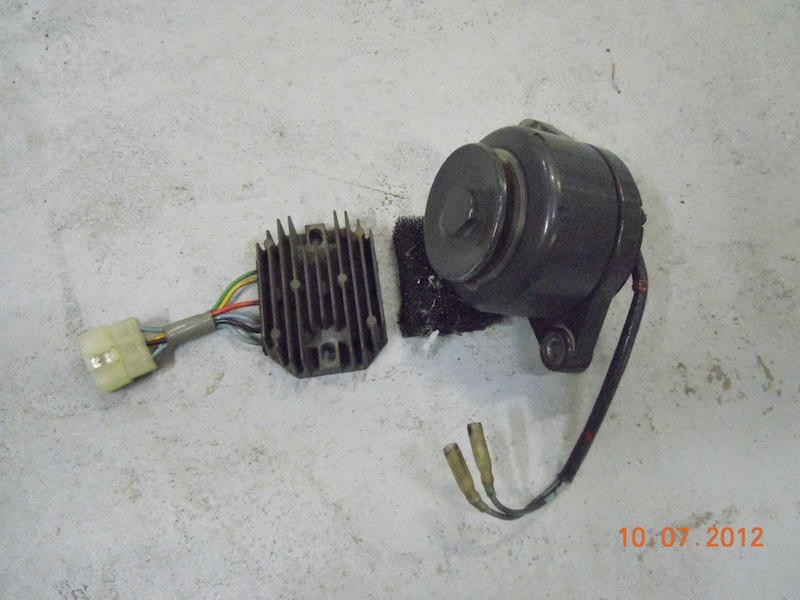
Fuel Filter Stupidity By Murray Morell
This is the first article on how to fix the Timmerman Electric Starter Phillip & the others that helped with this need a Nobel Prize these articles are free to view on the Members Only Area please use your current password provided in your monthly Smoldering Embers to use this area consider the benefits of Association Membership
Electric Moccasin Part 1 by Phillip White (These articles now transferred to Members Only Area Please think about joining about our Association as you get a newsletter & many great articles to read in this Area)
ELECTRIC MOCCASIN Part 2 update continued
New” Oils and “Old” Cars Don’t Mix
By Mark D. Sarine
Have you heard about the “zinc” problem with modern motor oils? Many classic car owners and racers have experienced camshaft failures due to modern motor oils. Even worse, be prepared for the “zinc” to change in motor oils again later this Fall.
If you’ve not had the pleasure of having your camshaft go flat due to modern motor oils, consider yourself very fortunate. As an owner of an engine parts warehouse, I’ve seen hundreds of perfectly good camshafts ruined by modern motor oils. So when I read about the “new” API SN motor oil coming out this Fall, I started talking to the engine builders we supply parts. The engine builders all said the same thing – car owners don’t much know about these modern motor oils and the problems these oils create in classic cars and race cars. Knowing about the Cruise News, I contacted Mike to see if he could help us spread the word – modern motor oils are not good for your classic hot rods and race cars.
Here’s the facts:
“Zinc” or ZDDP as it is commonly referred to in motor oils is a type of chemical called Zinc DialkylDithioPhosphate, and “Zinc” has been the most common anti-wear additive used in motor oils for the last 60 years. I just call it “Zinc” because it is easier to say and spell.
“Zinc” is a remarkable chemical that protects engine parts from metal to metal contact under heavy loads.
“Zinc” works by creating a film on the iron and steel parts in your engine. Unfortunately, “Zinc” also creates a film inside modern Three Way Catalytic converters. This “Zinc Poisoning” limits Three Way Catalytic converter life to around 70,000 miles.
The Federal Environmental Protection Agency (EPA) mandates that car manufacturers warranty Three Way Catalytic converters on new cars built since 2004 for 120,000 miles. To achieve this goal, the car manufacturers worked with the American Petroleum Institute (API) to create new, lower “Zinc” oils that allow Three Way Catalytic converters to live for 120,000 miles.
These new “Lower Emissions” oils have extended catalytic converter life, but they have shortened the life of flat-tappet camshafts.
Not long after these modern motor oils with less “Zinc” hit the market, we started to notice an increase in flat-tappet camshaft failures. At first, it was the race engine builders, so we shrugged it off as some new “trick” the race guys were doing that caused the problem. Then we started to see stock flat tappet camshafts going flat.
Things got ugly really fast. Every camshaft company started researching the problem. So did the Automotive Engine Rebuilders Association. Everybody wanted to know, why are cams going flat?
The answer was “Zinc”.
Lower “Zinc” oils work just fine in modern production car engines with overhead cams, and roller lifters. These modern engines don’t rev past 5,000 RPM.
Most hot rod and race motors have push rods, flat tappet lifters and rev beyond 5,000 RPM. These engines need motor with more “Zinc”.
The good news is that “High Zinc” oils are available.
If you have a classic car or race car, I highly recommend using the Joe Gibbs (or Penrite) brand oils.
We have seen a dramatic reduction in camshaft problems when our engine builders started using the Joe Gibbs brand oils. Since Joe Gibbs Racing is a NASCAR team, they are on top of all the latest advancements in technology, and they have developed oils that work. I’ve seen used parts from Joe Gibbs Racing engines that look brand new (even with over 600 miles on them).
If you’ve not had any problems so far, consider yourself very lucky. Switching to a “High Zinc” oil before the new API SN oils hit the shelves is like an insurance policy against having problems.
We like selling engine parts, but I hate seeing good parts go bad – Especially when they don’t have to.
by Mark D. Sarine
ETHANOL BLENDED FUEL. (Thanks to Classic M/cycle Club of S.Aust)
What is Ethanol? Well in simple terms it is alcohol distilled from waste green vegetation, like sugar cane. Australia accepted this as a boost to the cane industry as well greening our fuel.
There has been much talk about Ethanol and it’s effects when added to our petrol
but no one wants to make an official statement, in fact no statements of any kind have been made officially that answer our questions, or in essence to help to solve the new batch of problems that have arisen from tampering with our petrol. You be the judge.
The oil refineries now only make unleaded petrol, so additives, like ethanol are added to boost octane ratings up from what is really the old standard petrol. Ethanol is not the only additive used for this purpose, just the cheapest, and the most common. Australia had a limit set at 10 % (E10) but many samples show near 20% is being used, with this being planned as a new standard.
Some of the problems we have heard about are listed below.
- Hard starting in damp weather.
- Water in fuel. Blocking filters.
- Poor economy in normal everyday use.
- Dissolves tank sealant.
- Plays hell with fibre glass tanks. Dissolves them and the mess causes engine seizure.
- Corrodes metal fuel tanks causing petrol leaks
- If sitting for a couple of months, corrodes most metals.
- Corrodes inside the fuel jets causing lean mixture, and blockages.
- Rots fuel lines and tap seals, fire danger in the shed.
- Has a short tank life of about a month, and unstable octane rating.
- Swells rubbers in petrol taps and eventually stops petrol flow
